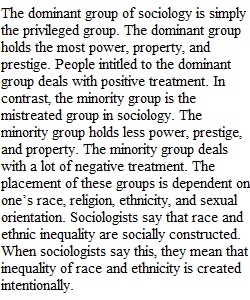


Q UWA SY100 – Chapter 10 Paper 8 The Social Construction of Inequality We have already examined in some detail what it means to say that race is Socially Constructed at the Macro- level with the term Racial Formation. We also said that race is socially constructed at the micro-level. Because race is not a fixed biological thing, at the individual level we all have learned to be or act out our race. There are also times when we are more aware of our race than others. There are times in our lives when we may identify with our race more or less depending on the situation. In sociology we call this changing sense of identity, Situational Ethnicity. Your textbook talks about a form of this called Symbolic Ethnicity. Members of Minority Groups tend to have a stronger and more lasting sense of Situational Ethnicity, than Majority/Dominant group members. For many members of the Dominant Group (the race group with more power, property, and prestige), micro-based race identity is not something that often factors into their sense of self. When asked about what they think of their race they often will say something like "I never thought about it". This is because for members of the Majority Groups, their race identity is more closely related to the larger culture of society and the standard point of comparison for others, it just feels "normal". For Majority Group members, in some ways this almost makes it seem like they do not have a race. On the whole feelings of racial or ethnic identity (or any minority status for that matter) tend to be stronger when: 1) The identity is clearly visible, easily identifiable, and harder to conceal. 2) The identity means being out-numbered significantly by people distinctly different 3) The identity is one that is meaningfully used to label people within the society 4) The identity is something used to discriminate against persons within the society Generally, before Inequality can be created, society and people need to develop a sense of In-group and Out- group identity around some characteristic or attribute. In-group and Out-group formation is about people with shared characteristics recognizing and grouping together according to these characteristics. Forming In-groups and Out-groups is NOT the same thing as creating Stratification or Inequality. In and Out is not about being better or worse, more or less, it is just about being different. Once the dynamic of in-group and out-group is socially constructed however, Prejudice and Discrimination, and Stratification are generally close behind. The absolute crazy thing about this dynamic is just how easy it is to create, even in the most artificial and obvious ways. Place a little social authority behind it and it can be downright scary. For this assignment I would like for you to see this happen, by examining a small piece of classic research on prejudice and discrimination. For ethical reasons we have all but eliminated this type of research from being done today, which makes this study all the more instructive and valuable. This entire movie is about 1 hour. You will only need to watch the first 19 or so minutes about the 3rd grade experiment for this paper. https://www.pbs.org/video/frontline-class-divided/ After you have watched this video, I would like for you to write a two-page paper (not counting the name and title page). In this paper I would like for you to: 1) Define and explain the terms Dominant and Minority Group; b) explain what it means when sociologists say that race and ethnic inequality are socially constructed, and c) explain what Dominant and Minority Groups are being socially constructed in the video experiment. 2) Define and contrast the terms Prejudice and Discrimination. Then provide specific examples from the video where each is created both formally (by the rules and regulations of the class) and informally (voluntarily and personally) among these research subjects. 3) What individual and social-level consequences resulted from the social construction of inequality within this society of students. In other words, how did this experiment impact individual kids in both the Dominant and Minority groups, and how did this experiment impact the class as a whole 4) What is the underlying sociological lesson we can take away from this video. (HINT: THE LESSON IS NOT THAT ALL THE KIDS WILL NEVER BE RACIST OR PREDUJICED, OR THAT THEY LEARNED A VALUABLE LESSON IN WHAT IT IS LIKE TO BE DISCRIMINATED AGAINST) As adult sociology researcher watching this experiment, what does the Conflict-Perspective tell us about group level processes and social inequality?
View Related Questions